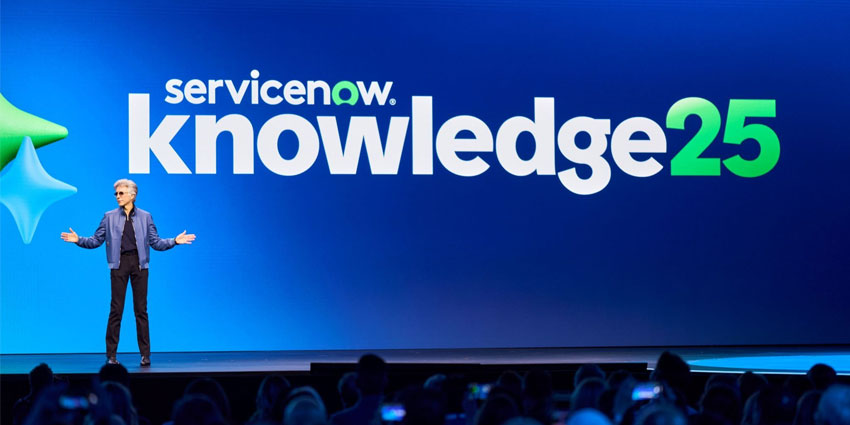ServiceNow Knowledge 2025 made a splash with a series of massive announcements.
First, the tech giant reintroduced the ServiceNow Platform as the “ServiceNow AI Platform”. It then announced several new partnerships, products, and even an acquisition.
In total, ServiceNow made 11 major moves.
Yet, beyond the headlines, Knowledge 2025 provided additional insight into ServiceNow’s vision and direction.
With that in mind, here are five top takeaways from the event.
1. ServiceNow Beckons a More Connected, Autonomous Enterprise
Historically, businesses have functioned in silos as if, for example, marketing doesn’t need access to supply chain data.
ServiceNow challenged this at Knowledge 2025 by launching its Workflow Data Network and AI Control Tower.
The Workflow Data Network extends ServiceNow’s Workflow Data Fabric. How? By connecting data from third-party systems and making it actionable within the ServiceNow AI Platform.
In doing so, it frees up the data available within solutions like Snowflake, so businesses don’t have to move data to power AI. They can leverage their existing investments.
The AI Control Tower then provides business leaders with the place to action that data.
Indeed, it offers business leaders a view of their entire enterprise systems so they can create new workflows between systems and deploy AI agents that share data and automate processes.
That lays the foundations for a more connected, autonomous enterprise.
Liz Miller, VP & Principal Analyst at Constellation Research, made this point in an interview with CX Today. She said:
The Data Fabric allows you to build on a composable architecture that spans the whole organization. So, whether it’s a core business application or something more niche, everything can now plug into a common data foundation. That enables true agent-to-agent handoffs without system interruptions.
ServiceNow’s new AI Agent Fabric, which allows businesses to not only leverage first-party AI agents but also agents from other vendors via the Control Tower, boosts this further.
Critically, it allows these agents to communicate, collaborate, and learn from each other.
2. “Knowledge” Takes on a New Meaning
ServiceNow brought Jensen Huang, CEO of NVIDIA, onto the stage to introduce a new AI reasoning engine. The “Apriel Nemotron15B” model allows AI agents to process feedback and self-learn.
Yet, perhaps most interestingly, the model can reason between the types of knowledge materials it takes information from and factor that into its decision-making.
So, the model scours emails, chats, PDFs, and documents and deciphers what’s most relevant.
Just as fascinating, the model may even suggest where that knowledge content should live.
In this sense, ServiceNow isn’t only actioning knowledge; it’s disseminating it. As Miller noted:
Imagine combining Adobe Acrobat AI with that reasoning engine—suddenly, you’re summarizing, translating, editing documents, and distributing knowledge seamlessly across platforms.
Miller then went on to suggest that, by introducing this solution, ServiceNow and NVIDIA are challenging enterprises to rethink what “knowledge” means.
It’s not just an FAQ or self-service tool anymore. Knowledge is enterprise-wide.
Indeed, the best answer to a customer query might be buried in someone’s email, not in a formal database. As such, businesses need to start thinking of knowledge as both structured and unstructured data: accessible, remixable, and distributed across different formats and channels.
That’s what ServiceNow is likely aiming for. “It’s looking at knowledge as an enterprise-wide asset, not something confined to specific functional silos,” said Miller. “And that’s a shift more vendors need to make.”
3. ServiceNow CRM Is the “Missing Piece” In ServiceNow’s Strategy
ServiceNow announced a new unified CRM platform, promising a “system of action” for customer support, sales, and field service.
Yet, the move is much more significant than ServiceNow entering a new market.
Indeed, ServiceNow has always focused on aligning organizations – integrating functions like HR, finance, supply chain, etc. – so everything flows within the same framework.
CRM allows ServiceNow to bring the customer into the center of the equation. That’s according to Miller, who noted:
Adding CRM centers the customer in those business actions and realigns CRM to what it was always supposed to be: something helpful, not something that makes people miserable.
In too many cases, CRM systems have made people miserable.
At first, businesses treated CRM as a silver bullet to fix sales force automation (SFA), hoping to enable productivity, improve selling capacity, and resolve credit conflicts between sales and marketing.
However, CRM stayed a tool; it never became a strategy. Many organizations have long been able to coordinate actions between customer-facing teams and share data. But few have achieved this, thanks to persistent strategic gaps.
“That’s what I think ServiceNow is addressing now,” said Miller. “These processes should be automated, and the goal should be integrating departments so businesses can focus on deeper strategic issues.”
That said, if organizations implement ServiceNow CRM the same way they’ve implemented every other CRM, they’ll only achieve marginal gains.
Indeed, the CRM in itself isn’t the show-stealer. What’s most fascinating is how it works with ServiceNow’s workflows and data fabric. That combination allows for end-to-end, cross-organizational workflows in service of employees and customers alike.
“CRM is just one missing piece, one that has been broken for a long time,” concluded Miller. “ServiceNow is filling that gap.”
4. Acquisitions Galore: But One Stood Out…
ServiceNow added to its string of acquisitions at Knowledge 2025, announcing an agreement to snap up data.world, the data catalog and governance platform.
The move will strengthen ServiceNow’s Workflow Data Fabric solution.
It also adds to ServiceNow’s string of acquisitions from 2025, with the provider snapping up Moveworks, CueIn, and Logik.ai.
For Miller, ServiceNow did an excellent job of isolating the benefits of the final acquisition at the event.
Logik.ai is a configure-price-quote (CPQ) solution. It isn’t a solution that solely focuses on helping sellers do a better job with couponing, discounting, and getting quotes out quickly. “Logik.ai also wants to create an immersive, interactive experience for the customer,” noted Miller.
By offering self-service capabilities, the customer can configure what they need and discover new options they didn’t know were available.
Moreover, the CPQ will be part of ServiceNow’s CRM platform. As such, it may consider data points like what the customer bought last time, whether they had service issues, and their support plans to make smart, tailored recommendations.
Meanwhile, via the self-service experience, companies gain new data about customer wants, needs, and priorities, which they can store in the CRM.
Typically, CRM-CPQs have operated out of lockstep. When people realize their CRM is broken but still need to sell, they install CPQ.
ServiceNow’s connected approach changes this and benefits both customers and sellers.
5. ServiceNow Is a Threat to Legacy SaaS Providers
ServiceNow recognizes that AI agents – from different providers – will interact across various enterprise platforms. No one ecosystem will rule them all.
Microsoft is thinking similarly, Oracle has fascinating multi-agent concepts, and SAP is making Joule cooperative with various systems to stay relevant.
Yet, ServiceNow’s pitch is: “Let our agents connect to SAP, so you don’t have to worry about SAP directly.”
That pitch may resonate with many, and AI agent plays from other horizontal infrastructure players – including the likes of Google Cloud, AWS, and the likes of Cognigy and Kore.ai – have momentum.
These aren’t the usual SaaS vendors, which could struggle to compete because customers may not view them as credible in this space.
Martin Schnieder, VP & Principal Analyst at Constellation Research, made this observation in a separate interview. In doing so, he compared ServiceNow and Salesforce.
“Salesforce came from the application side, which included some workflow capabilities,” he said. “Over time, they had to build out more and more workflow functionality, eventually acquiring MuleSoft to improve their workflow and integration capabilities.
“ServiceNow, on the other hand, started with workflow as its foundation and then added applications on top.
“What we’re learning with generative AI and other emerging technologies is that the application layer is actually the easier part.
The nature of applications is changing—they’re becoming less screen-oriented, more fluid, and increasingly headless.
“When you have strong workflow capabilities combined with agentic flows, that’s where the real advantage lies,” he concluded. “I wouldn’t even call it a ‘secret sauce’—it’s more like ‘killer sauce’.”
For Schneider, this gives ServiceNow “incredible potential”, but it may cause others some concern.







